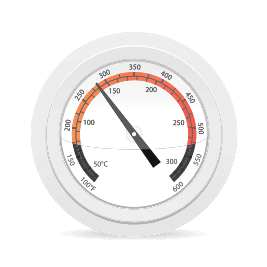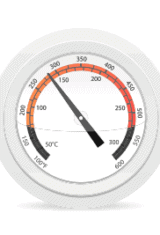Get our temperature conversion chart or use the temperature calculator, whichever is most convenient for you. Both will help to convert Fahrenheit to Celsius and vice-versa without having to use the formula.
I call temperature conversion a math exercise. The U.S. and imperial systems measure temperatures in Fahrenheit, while the metric system uses Celsius.

To convert Fahrenheit to Celsius, you will have to subtract 32, multiply this result by 5, and then divide by 9. (F -32 x 5 / 9). I don't know about you, but all that's a "No" for me!
To convert Celsius to Fahrenheit you will have to multiply by 9, divide by 5, and then add 32 (C x 9 / 5 + 32). I am already exhausted just thinking about it!
The formula for temperature conversion applies both to weather and cooking temperatures.
Water freezes at 32°F and boils at 212°F (at sea level) on the Fahrenheit scale. Keep this in mind when freezing foods and cooking as well. But on the Celsius scale, water freezes at 0°C and boils at 100°C (at sea level).
But you don't have to bother with that complex formula. Either use our calculator or our chart below!
Temperature Conversion Calculator
Moreover, you can print the chart for temperature conversion below and have it handy when you need it. If this applies to you, go ahead and print out our chart below! It is useful for me since I am from Brazil and have been living in the U.S.A. for almost 2 decades yet have not learned how to do temperature conversions in my head.
As if that weren’t enough, there are countries such as the U.K. that measure oven temperatures not only in Celsius but also using oven gas mark temps that vary from ¼ to 9+.
In Brazil, we simplify that by establishing 180° C (about 350° F) as the medium, usual or average temperature. Anything lower is considered medium-low to low on the temperature scale, and anything higher than that 180° C is medium-high or high.
See the chart for temperature conversion below, which features common temperature equivalents used in cooking.
Temperature Conversion Chart
| Description | Fahrenheit | Celsius | Gas Mark | |
|---|---|---|---|---|
| Freezer Storage | 0 F | -18 C | ||
| Water Freezes | 32 F | 0 C | ||
| Refrigerator Storage | 40 F | 4 C | ||
| Room Temperature | 68 F to 72 F | 20 C to 22 C | ||
| Lukewarm Water | 95 F | 35 C | ||
| Poach Temperature | 160 F to 180 F | 70 C to 82 C | ||
| Simmer Temperature | 185 F to 205 F | 85 C to 95 C | ||
| Boil Temperature | 212 F | 100 C | ||
| Very Cool Oven | 225 F | 110 C | ¼ | |
| Cool Oven | 250 F | 120 C | ½ | |
| Very Slow Oven | 275 F | 140 C | 1 | |
| Slow Oven | 300 F | 150 C | 2 | |
| Low/Warm Oven | 325 F | 160 C | 3 | |
| Moderate/Medium Oven | 350 F | 180 C | 4 | |
| Moderately Hot Oven | 375 F | 190 C | 5 | |
| Hot Oven | 400 F to 425 F | 200 C to 220 C | 6 to 7 | |
| Very Hot Oven | 450 F to 475 F | 230 C to 240 C | 8 to 9 | |
| Extremely Hot Oven | 500 F | 260 C | 9+ |
If you are baking at high altitudes (above 3,000 ft.or 915 mt.) you may need to increase your oven temperature by 25 F/5 C for most baked goods.
Other cooking conversions to use:
- U.S. cups to ounces to grams
- How many sticks of butter in a cup?
- Baking substitutions
- How many teaspoons in a tablespoon?
- Volume Conversions



